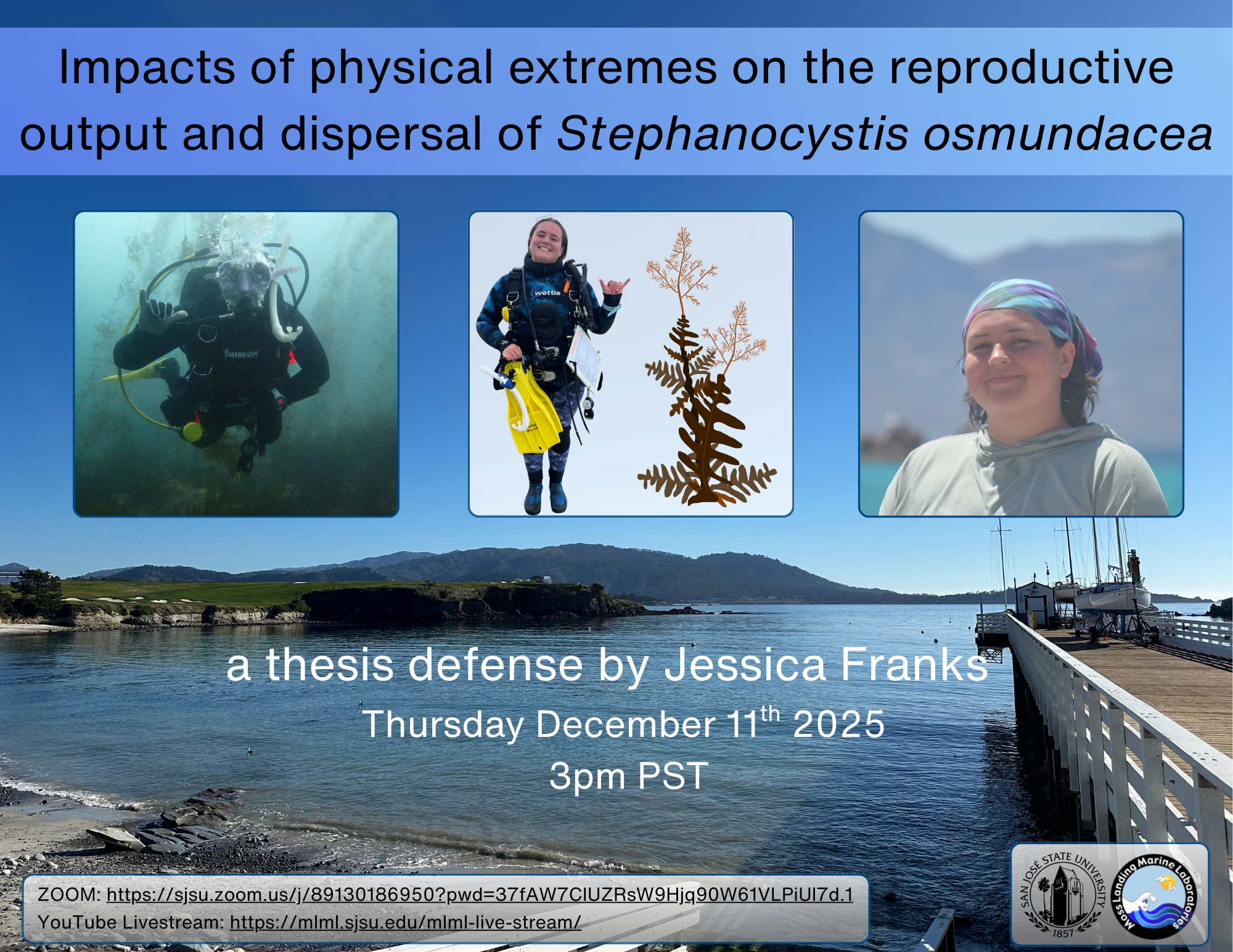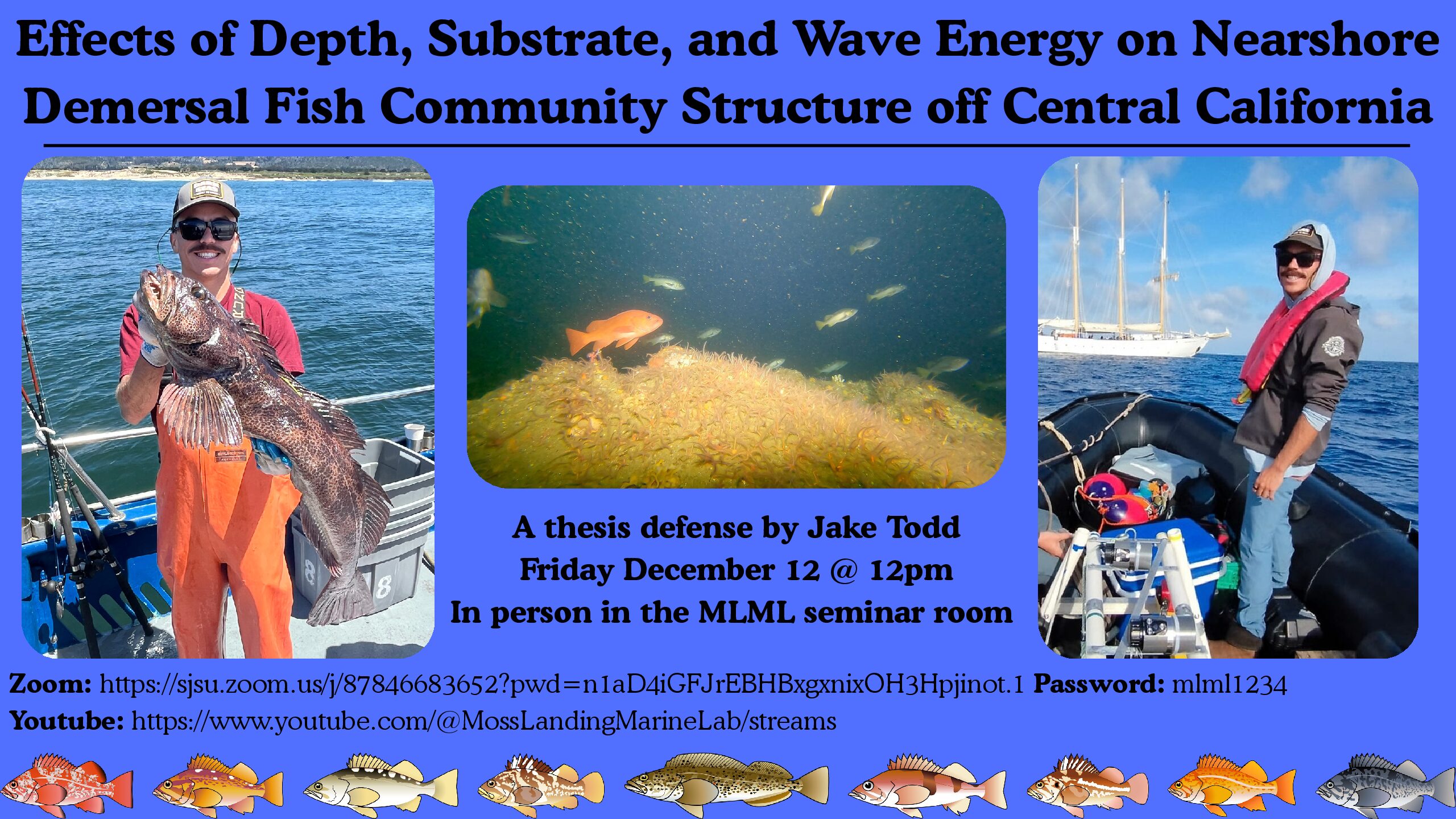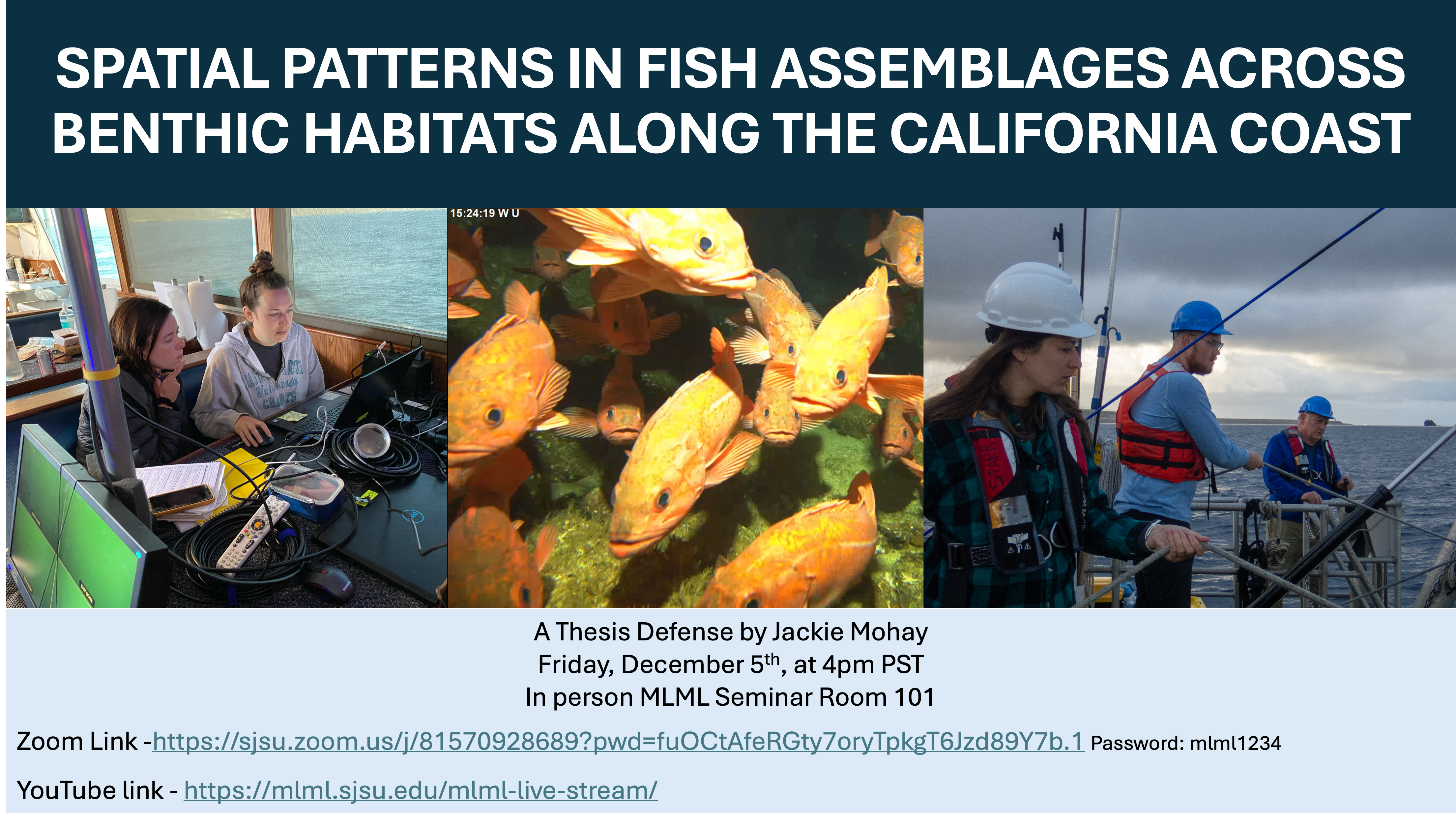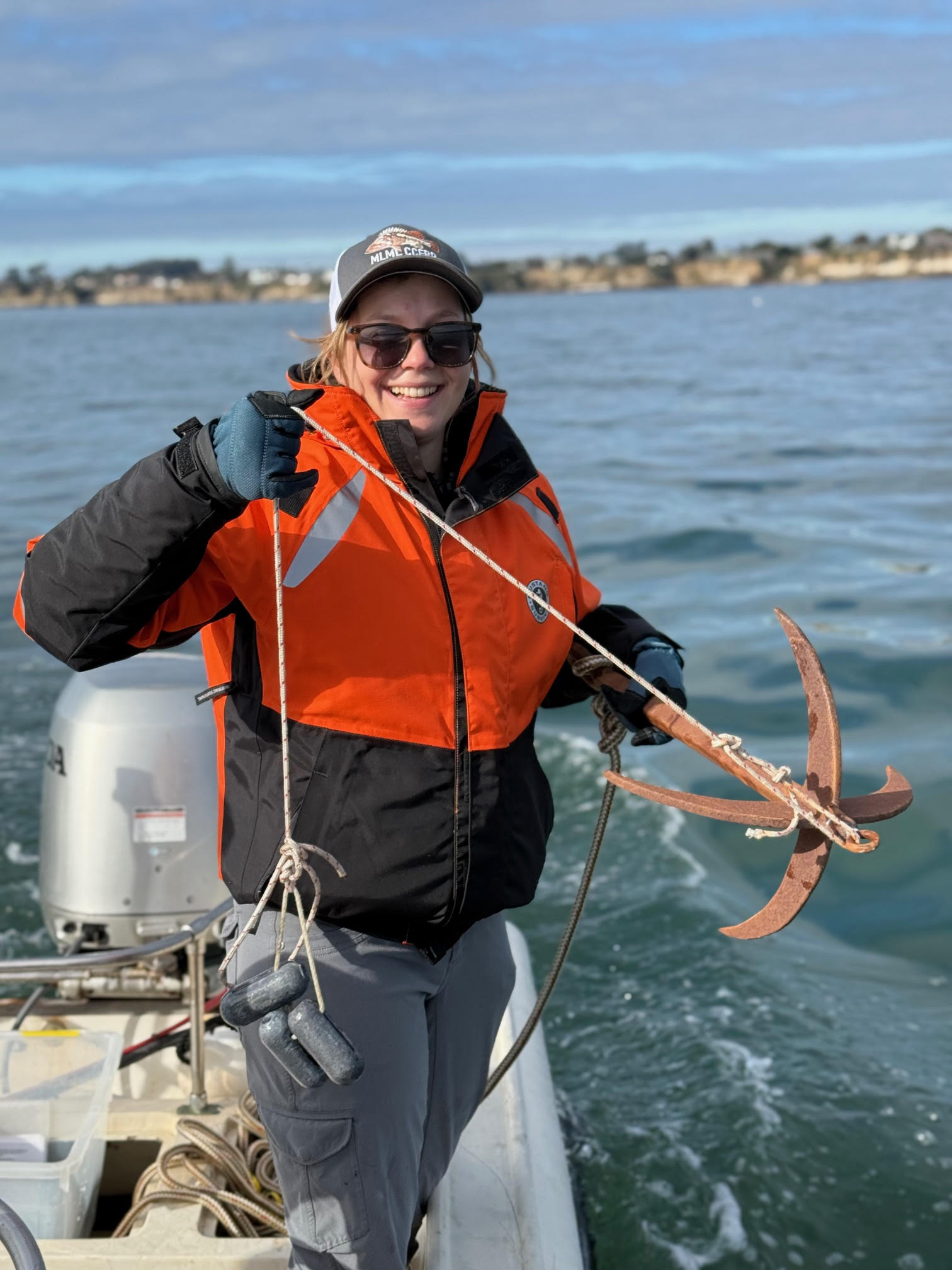"Assessing nursery habitat in Elkhorn Slough: Effects of hypoxia and elevated temperature on two juvenile flatfish species"
Wednesday, December 10, 2025
9:00 - 10:00 am PST

"Assessing nursery habitat in Elkhorn Slough: Effects of hypoxia and elevated temperature on two juvenile flatfish species"
Wednesday, December 10, 2025
9:00 - 10:00 am PST

"Impacts of physical extremes on the reproductive output and dispersal of Stephanocystis osmundacea"
Thursday, December 11th
3:00 - 4:00 pm.

"Effects of Depth, Substrate, and Wave Energy on Nearshore Demersal Fish Community Structure off Central California"
Friday, December 12th
12 - 1 pm.

"Spatial patterns in fish assemblages across benthic habitats along the California Coast"
Friday, December 5th
4:00 pm

"Oceanographic drivers of recruitment and reproductive potential of Gopher rockfish (S. carnatus) - Historical variability and future projections under climate change".

"Juvenile White Sharks in Monterey Bay: Effects of Thermal Habitat Patchiness on Local Densities of a Range Shifting Predator"
Live-Stream July 25th, 2025 at 3:00 pm PST

Abstract
Climate change has shifted species’ distributional ranges in many marine and terrestrial systems. For marine species, those shifts in ranges associated with ocean warming are often poleward or into deeper waters. Juvenile white sharks (Carcharodon carcharias) are one such species, having exhibited a 270 km range shift of the cold edge of their thermal range extending northward up to the Monterey Bay. However, little is known about the fine-scale habitat selection of marine organisms at the cold edge of their shifting range and how localized thermal gradients or warm pools may permit persistence in these newly inhabited locations. The Monterey Bay provides a unique study system with high spatial variability of environmental conditions, and a range-shifting endothermic predator, the white shark, that is highly mobile and known to be sensitive to ambient temperatures. This research investigates fine-scale habitat selection by juvenile white sharks in this dynamic system at the submesoscale (1-10 km) using remote sensing, aerial surveys, and acoustic telemetry to link spatial and temporal patterns of site occupancy with environmental conditions. Results indicate that increases in sea surface temperature (SST) and K490 (light attenuation coefficient proxy for turbidity) are significantly positively associated with juvenile white shark abundance from both remote sensing and acoustic telemetry perspectives. As juvenile white sharks extend their range northward, they may be utilizing pockets of warm water, enhanced by increased turbidity, as thermal refuges in regionally cooler areas. Additionally, higher residence times were observed at subsurface sites between the hours of 9:00 PM and 7:00 AM, indicating potential foraging behavior offshore before returning to coastal surface waters to rewarm. Understanding range shifts of predators is important as their presence in novel locations can result in changes in predator-prey interactions and new top-down effects on local ecosystems.
Bio
Kelsey grew up in both Southern and Central California, moving from Hermosa Beach in Los Angeles to Oakhurst in the Foothills of the Sierras with her sister, mom, and dad when she was ten. After graduating from high school, she attended Fresno State as a Presidential Honors Scholar. Initially entering as an Undeclared major, she found herself drawn to the sciences. She eventually declared as a Biology major with a Spanish minor, while maintaining a healthy level of involvement in the music department in her spare time. As she progressed through her program, she was able to travel to Clearwater, Florida, to participate in shark and ray research for two summers, solidifying her desire to pursue marine science. She was able to use these data to conduct her undergraduate thesis on the drivers of elasmobranch biodiversity in this area for Fresno State's Biology Honors Program, graduating in the Spring of 2022.
Looking for a way to expand her skillset, Kelsey decided to pursue a marine-related Master's degree, finding MLML as a program that could bolster her experience with research, course material, and practical skills in the marine sphere. Kelsey joined the Ichthyology Lab at MLML and the Ocean Predator Ecology Lab at CSUMB in the Fall of 2022, co-advised by Drs. Sal Jorgensen and Scott Hamilton. During her time at MLML, her thesis work has investigated how temperature, phytoplankton biomass, and turbidity are associated with juvenile white sharks within Monterey Bay after their novel appearance in 2014. However, she could be found helping others with their various projects, TAing at CSUMB, and working for MLML's California Collaborative Fisheries Research Program (CCFRP) and surf zone MPA monitoring programs in her spare time. She is excited to be making this next step towards her career and to see what new challenges await her on the other side of her Master's.



MLML Biological Oceanography & MLML Environmental Biotechnology
Live-Stream July 25th, 2025 at 10:00 am PST

Abstract
Monterey Bay, CA is a highly productive system that is threatened by warming sea surface temperatures (SSTs) and the bloom forming genus Pseudo-nitzschia (Pn) that can produce the neurotoxin domoic acid (DA). Since half of Pn species produce DA, species-level identification is critical for predicting DA events. I determined whether temperature (12 °C, 15 °C, 20 °C, 25 °C) impacts P. pungens, P. multiseries, and P. australis growth, toxicity, and community composition in batch cultures measuring biomass, growth rate, cell physiology, and toxin production. In Part A, Pn strains were cultured individually at different temperatures to establish baseline growth curves to develop a predictive model for Pn species biomass. In Part B, a mixed community of Pn was grown at current Monterey Bay temperatures (15 °C). Increased temperatures led to increased growth rates, biomass, and toxin production. P. multiseries had a wider thermal range than P. pungens. When initial biomass was equal, P. pungens and P. multiseries were predicted to reach maximum growth rates at 20.7 °C and 24.2 °C respectively. In a mixed community (15 °C), P. multiseries outcompeted P. australis and P. pungens based on cell concentration (cells μL-1). The observed species-specific thermal traits suggest that warming oceans may favor the dominance of toxic P. multiseries, thereby increasing the risk of DA events disrupting the marine ecosystem. This research furthers our understanding that temperature plays for forecasting species-specific toxic Pn blooms and mitigating their effects on marine life and coastal communities.
Bio
Hannah grew up in New York City for the majority of childhood. She earned her B.A. in Environmental Science, along with a minor in Managerial Economics, from Colby College in Maine. During her time as an undergrad, she had the opportunity to study at Bigelow Laboratory for Ocean Sciences where she got her first taste of fieldwork and sparked a lasting love for marine science. That spark quickly grew. The following summer, Hannah joined the Red Tide Institute at Mote Marine Laboratory as a Research Experiences for Undergraduates intern. There, she dove deeper into the world of harmful algal blooms, gaining hands-on experience both in the lab and out in the field.
In the fall of 2022, Hannah made the move to California to pursue her Master’s in Marine Science at Moss Landing Marine Laboratories, where she is co-advised by Dr. Holly Bowers and Dr. Sarah Smith. Since arriving on the West Coast, she’s taken on the role of Phytoplankton & Water Quality Specialist with the CALHABMAP (Harmful Algal Bloom Monitoring and Alert Program). Her work involves monitoring water quality and phytoplankton populations in Monterey Bay. Looking back, Hannah feels incredibly grateful for the journey, especially the mentors, family, and friends who have supported her along the way.



